A practical guide to bird watching in Sonoma County, California
(Unless otherwise indicated, all phone numbers are in the 707 area code)
A practical guide to bird watching in Sonoma County, California
(Unless otherwise indicated, all phone numbers are in the 707 area code)


BOOKS ABOUT LOCAL BIRDS AND BIRDING
other BOOK REVIEWS
© Colin Talcroft, 2009, 2010, 2011, 2012, 2013. All rights reserved.
Unless noted, all photos by the author. If you would like to use one of my images, please ask for permission for non-commercial use with proper credit or commercial use with proper compensation.
Field Guides
Which one for you?
There is no best field guide, but clearly some are more popular than others. All have strengths and weaknesses. The creation of every field guide involves many choices that ultimately determine the accuracy, completeness, attractiveness, size, weight, and cost of the book. Below I compare 10 of the most widely used field guides to birds of North America, Western North America, and Northern California. Each entry gives title, writer or editor, publisher, date of publication, list price, number of pages, number of species covered, dimensions (width x height x depth, in millimeters), and weight (in ounces and grams). These data are followed by comments. I've tried to compare: Coverage, organization, page layout, illustrations, text comments, extent of additional information accompanying entries for each species, extent of ancillary information elsewhere in the text, indexes, and bonus features.
The best local sources of bird books may be Wild Birds Unlimited, at 71 Brookwood Avenue, Santa Rosa, CA 95404 (576-0861), Wild Bird Center, at 1161 Yulupa Ave., Santa Rosa, CA 95405 (526-4323), and Copperfield's Books (stores in Healdsburg, Petaluma, Santa Rosa, and Sebastopol).
Also see BOOKS ABOUT LOCAL BIRDS AND BIRDING
and BOOK REVIEWS
 National Wildlife Federation Field Guide to Birds of North America
National Wildlife Federation Field Guide to Birds of North America
By Edward S. Brinkley
Sterling Publishing, 2007, $19.95
527 pages, 765 species, 123 x 197 x 36mm, 29oz (842g)
Following a pictorial table of contents (which serves as a kind of quick index) and a general introduction, this guide offers short sections illustrating the parts of a bird and plumage topography, sections on plumage and molt, on bird identification in general, on bird biology, and on birding strategies.
Species accounts follow. Organized taxonomically. Taxonomic groups are preceded by brief introductory essays. Mostly two species entries per page. Illustrated with photos--usually two for each species (typically showing a male and a female or a plumage variation when that is more relevant). A third, smaller photo is often inset to show juvenile plumage or another notable plumage feature. Range maps big enough to be useful are included on the species pages.
End material includes: Photo credits followed by an extensive glossary; a list of vagrant, rare, and extinct birds; a list of endangered and threatened birds in North America; a species checklist; a full index with common and scientific names integrated; and then a quick index. Inside front cover has a fold-out map of North America. A map showing major North American migration routes precedes the front matter and table of contents described above. Clear, simple, attractive layout, but species accounts perhaps lacking in the detail that more experienced birders are likely to want. Has no major faults, but seems to do nothing outstandingly well either (although the plumage topography illustrations are large and clear). Compact, but comparatively heavy at 29 ounces (842g). Offers 26.4 species/oz. compared with the fifth edition of The National Geographic Field Guide to the Birds of North America at 35.8 species/oz and Sibley's Birds of Western North America edition, at 35.2 species/oz.
 Birds of Northern California
Birds of Northern California
By David Fix and Andy Bezener
Lone Pine Publishing, 2000, $22.95
384 pages, 328 species, 140 x 215 x 18mm, 20oz (561g)
Although not specifically about Sonoma County birds, covers all the regulars. Probably the best simplified guide to local birds available. Makes up for comparatively small number of species covered (328) with the depth of the species entries. Opens with a "reference guide" that is actually a visual index with bird illustrations, sizes in inches, and page numbers for entries in the book. The wide-ranging introductory material covers the usual subjects and more: Birding in Northern California; beginning to learn the birds; tools and techniques of birding (binoculars, spotting scopes, birding by ear, watching bird behavior, birding by habitat, calling birds closer, bird listing and record-keeping); birding activities (birdwatching groups, bird conservation, bird feeding, nest boxes); and a geographical overview of bioregions of Northern California (ocean, coast, coast ranges, Central Valley, Klamath Basin, Modoc Plateau/Great Basin, Cascade Range, Sierra Nevada, and the urban environment). This section includes a map of the topography of Northern California, which is taken to extend as far south as the southern end of the Inyo Mountains--or roughly the northern two-thirds of the state.The introductory material concludes with notes about what information the species accounts contain.
Species accounts are split into non-passerines and passerines, then organized taxonomically. Taxonomic groups are preceded by brief notes (less extensive than in many other guides). One species per page. Illustrated with drawings. Big, clear, attractive illustrations (although the coloration in the drawings is a bit idiosyncratic in some instances). Text entries include more information than most field guides have room for, often including incidental information of interest, such as explanations of scientific names. Range maps are a bit small to be used for anything but a general picture of distribution. Entries attractively color-coded by taxonomic group. That and the large illustrations with one bird to a page make it easy to find birds by flipping through the pages. Overall, very attractively produced. Has the advantage of not including birds that rarely occur in the area, unlike the full Western or North American field guides, which makes it a good guide for beginners or people new to the area.
End material includes a checklist for Northern California, a limited glossary, a very basic illustration of bird parts, a bibliography, an index of common names, and a separate index of scientific names, followed by a short paragraph about the authors. Ordinarily I hate multiple indexes as they can be such time wasters, but this book is so easy to navigate without either index that it hardly matters. Inside covers blank. Rear cover has a visual quick guide to major bird groups that uses the same color coding as within the book. At 20 ounces, light as field guides go, but slightly wider than most, which can make it hard to fit into a jacket pocket or bag. Still, my book of choice for beginners and newcomers to Sonoma County, unless full coverage is a must.
 Field Guide to Birds of Western North America,1st ed.
Field Guide to Birds of Western North America,1st ed.
By David Allen Sibley
Alfred A. Knopf, 2003, $19.95
471 pages, 703 species, 120 x 195 x 28mm, 20oz (573g)
Sibley feels like an ideally updated Peterson, probably because it's illustrated with paintings rather than photographs, because it uses the system of arrows pointing to important field marks pioneered by Peterson, and because it's the work of a single man, like the original Peterson guides. People seem to like Sibley for a number of simple, but good reasons. First, and perhaps most important, it's dense. It has a great deal of information about habitat preferences, plumage variations, subspecies, vocalizations, and the like in compact paragraphs. Ounce for ounce, Sibley provides more information than any other similar guide (I'm referring here to the Sibley Western North America edition). It weighs only 20 ounces. Offering 35.2 species per oz., it's the lightest of the major field guides for Western Birds relative to the number of species covered. It also has the smallest dimensions. Only the Kaufman guide comes close in terms of small size and light weight.
Introductory material includes short but thorough discussions of the following topics: Classification of birds; birding (equipment, finding birds, learning to identify birds); variation in appearance (geographic variation and subspecies, polymorphism, wear and fading, changes in posture and head shape, light and atmospheric conditions, cosmetic coloration and staining, aberrant plumages, bill deformities, and hybrids); molt and plumage; learning songs and calls; finding rare birds; ethics; extinct species; and conservation. A key to the species accounts follows, that followed by a seven-page section on bird topography with many illustrations.
Species accounts are arranged taxonomically. Taxonomic groups are preceded by brief notes and a visual guide to the page numbers for species within the larger groups. Usually two species shown per page, sometimes one if numerous ancillary illustrations have been included for a particular species. Illustrated with paintings rather than photos, as noted above. Small but useful range maps that appear under species accounts include migration information. No comparative plates of related birds in flight except for diurnal raptors. All other flight illustrations appear in species entries.
End material: Species accounts are followed by a page of acknowledgements and a full index (common and scientific names integrated). A quick index follows the main index. Inside front cover repeats some of the bird topography illustrations that appear inside and gives a key to the range maps. Long front and back cover flaps can be used as place markers. Back inside cover printed with map of North America. While I'd prefer the quick index separated from the main index--perhaps on the back outside cover of the book--and the illustrations sometimes feel overly stylized to me, generally an excellent resource.
 Smithsonian Field Guide to the Birds of North America
Smithsonian Field Guide to the Birds of North America
By Ted Floyd
HarperCollins Publishers, 2008, $24.95
512 pages, DVD with 587 bird songs, 755 species, 150 x 203 x 28mm, 33.5oz (949g)
Opens with brief introductory material discussing bird identification in general and then an extensive explanation of the guide itself (touching on coverage, noting the group accounts that precede taxonomic groups, and then explaining the species accounts, which include names, measurements, natural variation, habits and ecology, vocalizations, range maps, and photograph and caption text). That is followed by a detailed section headed "Natural History of Birds" covering: Where to look for birds (Forest and woodlands, Prairies and meadows, deserts and shrublands, alpine and arctic tundra, wetland and aquatic habitats, and human habitats); Bird behavior (Food and foraging, Bird vocalizations, Courtship and breeding, and Flight and migration); Parts of a bird (with photographic and schematic representations of typical ducks, songbirds, raptors, and gulls); Plumage and molt; and then a section on strategies for identifying birds headed "How to identify birds."
Species accounts are illustrated with photographs. Each page presents only one or two species, but rather than a single large photo to represent the most common plumage, the guide presents examples of different plumages and birds in flight. Organized taxonomically. Taxonomic groups are preceded by comparatively extensive notes on taxonomic groups. Comparatively large range maps are presented at the end of species accounts. These include migration information. No comparative plates of similar birds in flight. Photos of birds in flight are included in species accounts, as noted above.
End material: Species accounts are followed by acknowledgements, recommended references and resources, photo credits, an explanation of the accompanying birdsong DVD (which includes 587 sound files for 138 North American species), a glossary, the current American Birding Association (ABA) checklist at the time of publication (2008), an integrated index (common and scientific names together and nicely separated visually--the common names are in boldface), and finally a quick index. Inside front cover is printed with a map of North America, a short list of plumage, molt, and age terminology, and an explanation of ABA codes indicating how common a given bird is (these codes appear in the species accounts). Rear inside cover is blank (DVD attaches here). Large front and back flaps usable as place holders. Comparatively large format at 150mm wide (5.9 inches) and comparatively heavy, at 33.5 ounces. Offers 22.5 species/oz. compared with the fifth edition of The National Geographic Field Guide to the Birds of North America at 35.8 species/oz and Sibley's Birds of Western North America edition, at 35.2 species/oz.--relatively few, although that's better than the Stokes guide (see below), which offers only 17.8 species/oz, the least of the major North American guides.
 Stokes Field Guide to the Birds of North America (1st ed.)
Stokes Field Guide to the Birds of North America (1st ed.)
By Donald and Lilian Stokes
Little, Brown, 2010, $24.99
792 pages, 600+ bird vocalizations on CD, 854 species, 142 x 215 x 39mm, 48oz (1,380g)
Heavy. The Stokes guide is thick and weighty. It's no wonder most people who like it consider it more a home reference book than a book to carry in the field. Its strong point is the large number of photographs it contains. It shows many variations of plumage by subspecies, age, season, and sex. This is especially useful in the case of the gulls, warblers, and sparrows. Its weakness is its size and weight--an inevitable result of the emphasis on photographic documentation, which requires many pages (nearly 800) and high-quality coated paper. At 48 ounces, it's by far the heaviest of the guides compared here. Offers only 17.8 species/oz, the least of the major North American guides and only half the best guides in terms of species relative to weight (Sibley's Western edition and the National Geographic guides).
Introductory materials include an explanation of how to use the guide, with paragraphs on area and species covered, and a detailed explanation of the species accounts. The accounts include photographs and captions; species name; birding code; length; shape; age and seasonal plumage descriptions; plumage dates; flight; voice; information about habitat, subspecies, and hybrids; and range maps. A six-page section on parts of a bird follows (based again on photographs rather than drawings).
Species accounts are heavily illustrated with photographs. Each page presents only one or two species, but rather than a single large illustration or photo to represent the most common plumage, the Stokes guide presents numerous examples of different plumages. Organized taxonomically. Taxonomic groups are not, however, preceded by the usual brief notes on taxonomic groups. Instead, there are interspersed text boxes offering general ID tips for each group. Small range maps are presented at the end of species accounts. These include migration information. No comparative plates of similar birds in flight. Photos of birds in flight are included in species accounts, but there are comparatively few of these.
End material: Species accounts are followed by acknowledgements; a cursory glossary; a key to codes for states, provinces, and international locations; photo credits; and an integrated index (common and scientific names together). Inside front cover gives detailed explanation of how the species entries are organized and the information they contain, repeating information inside the book. Rear inside cover repeats the basics of the (more extensive) information about parts of a bird found inside the book. Large flaps front and back usable as place holders. Quick index to main birds on front cover flap. Back cover flap has biographical information about the authors. Includes CD with over 600 vocalizations of 150 common species and a downloadable booklet with song and call descriptions and 150 additional photos. The final page of the guide lists the birds included on the CD and gives their track numbers on the disk. Personally, I like this guide as a reference at home or to keep in the car, but I would never carry it in the field. It's simply too cumbersome.
 Field Guide to Birds of North America
Field Guide to Birds of North America
By Kenn Kaufman
Houghton Mifflin, 2000, $18.95
391 pages, About 700 species, 120 x 197 x 24mm, 21oz (588g)
Opens with a pictorial table of contents and a quick key to the range maps. Introductory material that follows is detailed and wide-ranging--more so than in most field guides. Includes essays on: Getting started in birding (Birding and birdwatching: what's the difference?, how to be a great birder); Where when and how to find birds (Where to look, when to look, on the search, using this field guide); The two essentials: A field guide and a binocular (Choosing a binocular, using a binocular, spotting scopes); Bird topography and field marks; What to look for on an unfamiliar bird (Size, bill shape, shape and posture, behavior, habitat, field marks, bird voices, pitfalls of bird identification, variation in birds, the final ingredient); Birds in place and time (Range maps, the value of local information, birds through the year, keeping lists, writing it down, birding events); Feeders and other means of attracting birds (Planting for birds); Conservation (Endangered species, habitat, shade-grown coffee, cats indoors, ecotourism as a force for conservation, organizations that deserve support); How birds are classified and named (Species of birds, subspecies (races), scientific names, English names, standardized names, checklist order, changes in how birds are classified).
Species accounts are arranged loosely taxonomically, but in idiosyncratic color-coded groupings. For example, grebes are preceded by a section called "Coots, gallinules, and small grebes." Auks are divided into "Large auks," "Small Western auks," and "Small Northern auks." "Huge aerial waterbirds" groups the pelicans with Northern Gannet and Magnificent Frigatebird. Woodpeckers are divided into five sections by general appearance (for example "Zebra-backed woodpeckers" and "Black-and-white woodpeckers"). This feature may please those that use this as their first field guide, but it seems likely to annoy people used to strict taxonomic order. Taxonomic groups are preceded by very brief notes. Mostly four species shown per page, but the range is two to five. Illustrated with photographs separated from backgrounds. Small range maps that appear next to species accounts include migration information. Good textual voice characterizations. No comparative plates of related birds in flight. All flight illustrations appear in species entries, but flight examples comparatively few. Pages tend to have a cluttered look, in my view. No thumb tabs, but color-coding may help to visually separate sections.
End material: Species accounts are followed by a list of sources for further reading, a page of acknowledgements, photographer credits, and a checklist/index that includes English names only. The final page is a quick index. Inside front and back covers are blank, which seems a missed opportunity. No flaps. While this guide has good introductory material, that is mostly detailed text birders are unlikely to read in the field. The main species pages seem cramped. This is not a personal favorite, although Kaufman's books on advanced birding are excellent and highly recommended. On the upside, this is among the smallest and lightest complete North American guides available, weighing only 21 ounces (second only to Sibley's Western guide) and offering a respectable 33.3 species/oz.
 National Geographic Field Guide to the Birds of North America (6th ed.)
National Geographic Field Guide to the Birds of North America (6th ed.)
Edited by John L. Dunn and Jonathan Alderfer
National Geographic, 2011, $27.95
574 pages, 990 species, 138 x 203 x 28mm, 31oz (886g)
Introductory material includes a few paragraphs on each of the following topics (slightly rearranged for this edition): Species selection for the book; bird families, scientific names, and subspecies; identifying birds in general; behavior; voice; molt and plumage sequences; parts of a bird (large illustrations moved here from the inside front cover in the preceding edition); plumage variation; measurements; abundance and habitat; and range maps, followed by brief tips on becoming a better birder.
Species accounts follow. Organized taxonomically. Taxonomic groups are preceded by brief notes (less extensive than in many other guides). Ranges from one to five species per pair of pages, but mostly two to three, which gives a slightly less cramped feel than the preceding edition. Illustrated with paintings rather than photos. Migration information (and indications of subspecies ranges for 59 species) have been added to updated range maps that are big enough to be useful. Range maps and species accounts are presented on left-hand pages, illustrations on right-hand pages. (See below for more on subspecies range maps.) Ducks, shorebirds, raptors, and immature gulls shown in flight on separate plates. Ninety-two accidental and extinct species are illustrated and described briefly in shorter entries following the main species entries.
End material: Species accounts are followed by new larger range maps showing subspecies for 37 species (four maps to a page). An appendix includes notes on differences between the American Ornithologists Union (AOU) and American Birding Association (ABA) checklists for North America and paragraphs about Greenland and Bermuda. Ends with art credits, paragraphs about the authors, and acknowledgements. Full index (common and scientific names integrated) follows. Inside front cover now has fold-out visual index to bird families (non-passerines), rear inside cover the same for passerines. Quick index to main birds is now in front cover flap. Back cover flap shows legend for range maps. Flaps usable as place holders. Seven thumb tabs (Hawks, Sandpipers, Gulls, Flycatchers, Warblers, Sparrows, Finches) are a nice feature.
As previously, strengths are probably the thumb tabs and quick index (which make it very easy to find birds quickly) and the wide coverage (this guide covers more species than any of the other major North American guides). According to the cover, 300 new illustrations have been added, but I find it hard to see major differences from the previous edition. The book is among the heaviest (at 31 oz), but it offers 31.9 species/oz, more relative to weight than most. A good reference guide. Although I never carry this book in the field, it's among the ones I most often keep in my car while birding.
 National Geographic Field Guide to the Birds of North America (5th ed.)
National Geographic Field Guide to the Birds of North America (5th ed.)
Edited by John L. Dunn and Jonathan Alderfer
National Geographic, 2006, $24.00
502 pages, 967 species, 138 x 201 x 26mm, 27oz (771g)
Superseded by the sixth edition (see below), but still widely used. Introductory material includes a few paragraphs on each of the following topics: Species selection for the book; bird families, scientific names, and subspecies; identifying birds in general; parts of a bird; molt; plumage variation; plumage sequences; measurements; voice; behavior; abundance and habitat; and range maps, followed by brief tips on becoming a better birder.
Species accounts follow. Organized taxonomically. Taxonomic groups are preceded by brief notes (less extensive than in many other guides). Mostly three to five species entries per page, which sometimes gives a cramped look. Illustrated with paintings rather than photos. Range maps big enough to be useful are included next to the species accounts where appropriate. Range maps and text are presented on left-hand pages, illustrations on right-hand pages. Ducks, shorebirds, raptors, and immature gulls shown in flight on separate plates.
Seventy-one accidental and extinct species are illustrated and described briefly in shorter entries following the main species entries, followed by notes on differences between the American Ornithologists Union (AOU) and American Birding Association (ABA) checklists for North America and by paragraphs about Greenland and Bermuda. Full index (common and scientific names integrated) follows. Ends with art credits and acknowledgements. Inside front cover has quick index to bird families and fold-out illustrations of parts of typical birds and of feather topography. Inside back cover has quick index by main bird types and fold-out map of North America. Flaps usable as place holders. Seven thumb tabs (Hawks, Sandpipers, Gulls, Flycatchers, Warblers, Sparrows, Finches) are a nice feature. The strengths are probably the thumb tabs and quick indexes (which make it very easy to find birds quickly) and the wide coverage (this and the guide below cover more species than any of the other major North American guides). On the downside, with about 20 different contributors, the illustrations are inconsistent (and some are a bit cartoonish), and the book is fairly heavy (at 27 oz). Having said that, this guide offers 35.8 species/oz, more relative to weight than any other guide reviewed here. A good reference guide. Although I never carry this book in the field, it's among the ones I most often keep in my car while birding.
 Am. Museum of Natural History Birds of N. America: Western Region
Am. Museum of Natural History Birds of N. America: Western Region
Edited by François Vuilleumier
Dorling Kindersley, 2011, $19.95
480 pages, 575 species, 130 x 222 x 22mm, 26oz (743g)
Introductory material includes a section explaining the layout of the book, followed by essays on: Evolution; anatomy and flight; migration; courtship and mating; nests and eggs; and identification.
These are followed by the species entries. I like this guide in some respects--chiefly for its format: It covers 375 species with large photographic illustrations, with only one species to a page, which makes birds easy to find without resorting to the index. Birds are neatly isolated from their backgrounds for clarity. Less usefully, another 200 species called "rare species" are collected at the back of the book with entries four to a page. Taxonomically arranged in each of the two sections. Major taxonomic groups are preceded by a page or two with general information about that group. Main entry pages include numerous small photos showing alternate plumages, sex differences, juveniles, similar species for comparison, and, frequently, examples of birds in flight. These small photos are a bit too small in some cases, and the print generally is quite fine, which may be difficult for some people, but the pages are laid out clearly and attractively. Range maps, too, are small but handy on the main pages, which also include schematics showing typical flight patterns. Room for noting dates and locations of sightings at the bottom of each page (room for six sightings of each species) is an unusual feature.
List of vagrants and accidentals at the back of the book (unillustrated). Useful glossary at back, but print is very small. Integrated index (one index that includes both common and scientific names). No quick index, however. My main complaints are the barely readable print in the back sections of the book, the comparatively small number of species covered, and the fact that the "rare species" section includes some that are quite common: Greater Scaup, Elegant Tern, Eurasian Collared Dove, Nuttall's Woodpecker, Wrentit, and--bizarrely--Oak Titmouse and California Towhee among them. Also, splitting out these less common species has the effect of breaking up groups of similar birds (with some at the front of the book, others toward the back), which can make comparisons tedious. Offers only 22.1 species/oz. compared with the fifth edition of The National Geographic Field Guide to the Birds of North America at 35.8 species/oz and Sibley's Birds of Western North America edition, at 35.2 species/oz. This is therefore a comparatively heavy book relative to its coverage.
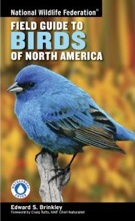
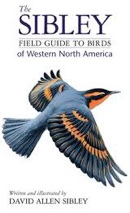
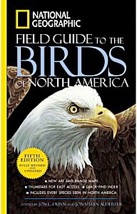
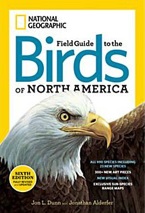
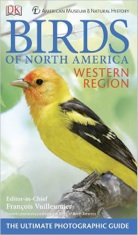
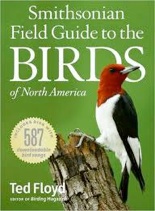
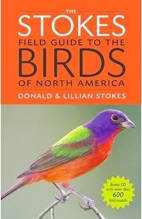
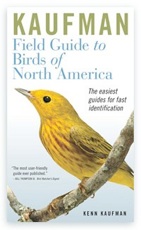
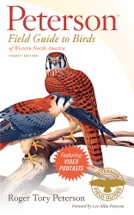

 Field Guide to Birds of Western North America, 4th ed.
Field Guide to Birds of Western North America, 4th ed.
By Roger Tory Peterson
Houghton Mifflin Harcourt, 2010, $19.95
494 pages, link to video podcasts, 675 species, 133 x 218 x 28mm, 26.5oz (724g)
The most recent edition of what is still to many the quintessential field guide.
Introductory material includes paragraphs on how to identify birds that point out what to look for in making bird IDs--each point illustrated with a black-and-white drawing. Other sections cover bird calls, bird nests, conservation, an explanation of the maps and ranges of birds included in the guide, a section on habitats and subspecies, and one on variation. The plates will be familiar to the generations that have grown up with Peterson's paintings and the system of small arrows indicating key field marks. Has an old-school feel because of its roots in predecessor editions, but it still does well what it's always done well--provide clear, simple illustrations that somehow capture the quintessence of a species.
Species accounts are organized taxonomically. Taxonomic groups are preceded by very brief notes (less extensive than in some guides). From one to six species per pair of pages, but mostly three to four. Nicely laid out. Never looks cramped. Illustrated with paintings rather than photos. Migration information included on small range maps that appear next to species accounts, but Peterson is unique in also including larger maps for almost every species in a separate section at the back of the book. The small range maps and species accounts are presented on left-hand pages, illustrations on right-hand pages. Geese, ducks, shorebirds, raptors, immature gulls and other groups shown in flight on separate plates--a feature Peterson pioneered. Also includes silhouettes of many bird groups and close-up illustrations of the heads of some groups of birds--for example, plovers, sandpipers, terns, gulls, and parrots.
End material: Species accounts are followed by the large range maps and these by a checklist, and then an integrated index (common and scientific names together). Inside front cover advertises bonus podcasts available to supplement the text online (species profiles, family overviews, tutorials for the field guide, and a biography of Roger Tory Peterson), as well as a key to the range maps. Other front material includes a quick index, a basic illustration of bird topography, a sketch of the underside of a typical wing, and a map of the area covered by the book. Inside back cover and final page of the book are occupied by shorebird silhouettes and silhouettes of roadside birds. No fold-out flaps. Considerably bigger and heavier than the 3rd Edition it replaces--which may be why many birders prefer to carry the older book. The newer (4th) edition weighs in at 26.5 ounces and offers 25.5 species/oz, both middle-of-the-road figures.
Sample page
Click to view
Sample page
Click to view
Sample page
Click to view
Sample page
Click to view
Sample page
Click to view
Sample page
Click to view
Sample page
Click to view
Sample page
Click to view
Sample page
Click to view
Sample page
Click to view